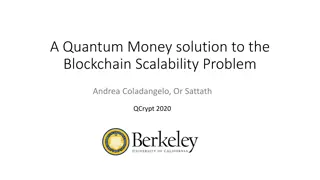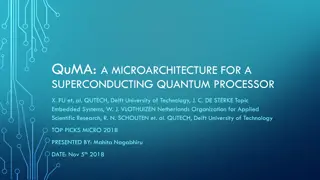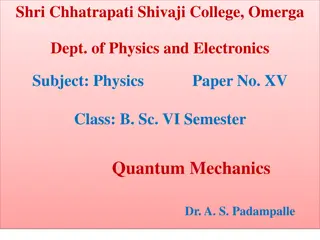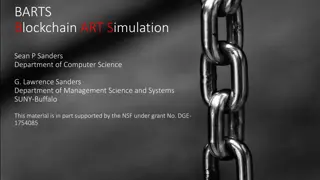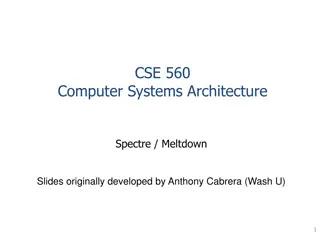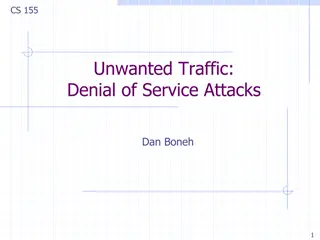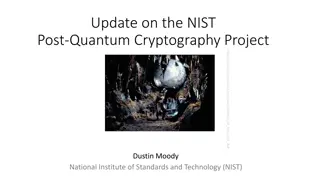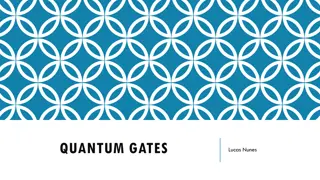Understanding Blockchain Vulnerabilities to Quantum Attacks
Explore the vulnerabilities of blockchains to quantum attacks and the potential impact of quantum devices on blockchain technologies. Learn about key concepts such as blockchain basics, proof-of-work, quantum computing, quantum computing algorithms, and vulnerabilities like ECDSA and peer-to-peer networks.
Download Presentation

Please find below an Image/Link to download the presentation.
The content on the website is provided AS IS for your information and personal use only. It may not be sold, licensed, or shared on other websites without obtaining consent from the author. Download presentation by click this link. If you encounter any issues during the download, it is possible that the publisher has removed the file from their server.
E N D
Presentation Transcript
Blockchain Vs. Quantum Attacks: The Quantum Advantage Joseph Kearney
Key Takeaways The aim of this talk is to demonstrate: The key vulnerabilities of blockchains to quantum attackers The potential use cases of quantum devices to improve blockchain technologies We will only be talking about major public networks
Blockchain Basics Chronologically linked series of blocks Each block contains a number of transactions Each transaction denotes the movement of data (cryptocurrency) from one account to another. Ownership and authority to move data is controlled by digital signatures Order and addition of blocks is controlled by consensus algorithms, most notably Proof-of-Work
Blockchain Basics Proof-of-Work Generally NP-Hard Problems Difficult to calculate but trivial to verify Race to see which miner adds the next block and therefore receives a block reward. ECDSA Relies on the hardness of Discrete Logarithms Used for proving authority over the cryptocurrency being transacted.
Quantum Computing Algorithms Shor s Algorithm Sub-Group finding algorithm Based on Quantum Fourier Transform and can be used to calculate the solutions to discrete log and factoring with an exponential speedup Reduces the amount time complexity to solve for a private key from its public key from approximately ?(2?) to O ?3. Grover s Algorithm Amplitude Amplification Quantum search algorithm that can be used to search unstructured search spaces with a quadratic speedup. Reduces the amount time complexity to solve Proof of Work for a given block from approximately O(?) to ? ? . Where N is ? 232where ? is the difficulty of mining the given block.
The Vulnerabilities ECDSA Vulnerable to Shor s Algorithm Proof of Work Vulnerable to Grover s Algorithm Peer to Peer Network Vulnerable to Shor s
Analysis We analysed 5 different blockchain protocols and determined the extent of their underlying vulnerabilities to quantum attack. Bitcoin Litecoin Ethereum Monero Zcash Partial analysis was also performed on several smaller cryptocurrencies Bitcoin Gold Bitcoin SV Bitcoin Classic BEAM Grin
Bitcoin Use of ECDSA and the underlying secp256-k1 is vulnerable to quantum attack. Hijack of transactions is the primary route of attack against Bitcoin Transactions that have been declared to the network that have not yet been incorporated into a block. The public key that has been declared by the sender of the transaction can be used by the attacker to solve for the private key The attack can then declare a duplicate transaction, sending the output to any address they desire.
Ethereum Ethereum incorporates and account based system associated to a single public key which is reused. Once an account and therefore its associated public key have been used, all ether kept by the account can be vulnerable to attack. A quantum attacker that solves the public key for the private key can therefore forge transactions in the account owners name by creating a valid signature. This is compounded by the contents of each account being easily and openly accessible through block explorers e.g. Etherscan
ZCash Contains one of the most severe vulnerabilities to quantum attack. Utilisation of the SNARKS Zero-Knowledge proof protocol to enable obfuscated transactions. This requires a trusted set up, which involves the production of a public parameter (public key where no one entity holds the private key). This production of an aggregate public parameter relies on the hardness of discrete logarithms, as well as the honesty of at least one user. Using a quantum computer to solve the public parameter for the unknown private counterpart would allow an attacker to produce Zcash tokens at will.
Proof of Work Definition 1)The computational complexity of the problem must satisfy: Time Complexity to Verify Time Complexity to Solve. 2)The difficulty of the problem must be easily tuneable with a parameter.
51% Attacks Among the most damaging attacks capable against blockchain technologies utilizing Proof of Work If a single malicious entity holds more than 50% of the network computing power then they have a 50%+ chance of adding the next block. Over time this could allow an attacker to reorganize the blockchain. Immutable transactions could be changed and removed False transactions could be added. Most PoW based blockchains these attacks are almost impossible to perform due to extremely high network hash rates. Successfully performed against some smaller networks such with lower hash rates such as Ethereum Classis
Proof-of-Work against quantum devices If we make the assumption that both quantum and classical devices follow Moore s Law. In fact it has been observed that quantum devices may in fact be exceeding this rate and classical devices have stopped following Moore s Law It is conceivable that a single quantum computer could compute enough hashes as to give themselves a probability greater that 0.5 to mine each block. This would allow the quantum assailant to perform a 51% attack against the network. This means that they could produce blocks at such a rate that they consistently produce the next block in the longest chain. This would allow them to have complete control of all transactions in each block. Allowing them to add false or invalid transactions. This attack over a prolonged period would completely decimate a blockchain network both from the perspective of reputation as well as the overall database.
Quantum Miners Initial Introduction of Quantum Computers to the Mining Pool More Quantum Computers Mining What if quantum devices instead of being utilized as malicious devices could be used as profitable crypto miners? Quadratic increase in power when compared to a comparable classical device Incentivising Causes Higher Profit Margin for Quantum Miners Higher Average Individual Hashrate Leads To Creates Higher Quantum Average Increased Difficulty Parameter Provides
Quantum Miners Can Save the Planet? Energy is consumed in information technology when information is deleted: Landauer s Erasure Quantum devices are reversable i.e. information is not deleted throughout the calculation only at the end, reducing the energy consumption We calculate that assuming quantum devices are as inefficient as classical devices 99.999% of the current Bitcoin mining capacity. Potential near term use-case for quantum devices
Bibliography [1] Aggarwal D, Brennen G, Lee T, Santha M, Toma michel M Quantum attacks on bitcoin, and how to protect against them. Ledge Oct 2018;3. [2] Shor PW Algorithms for quantum computation: discrete logarithms and factoring. Proceedings 35th annual symposium on foundations of computer science. Ieee; 1994. p. 124 34. [3] Grover LK Quantum mechanics helps in sear ching for a needle in a haystack. Phys Rev Lett Jul 1997;79:325 8. [4] Hopwood D, Bowe S, Hornby T, Wilcox N Zcash protocol specification Tech. repp. 2016 1.10. Zerocoin Electric Coin Company, Tech. Rep.; 2016. [5] Kearney, J.J. and Perez-Delgado, C.A., 2021. Blockchain Technologies Vulnerability to Quantum Attacks. Array, p.100065.+
Thank-you for listening Any Questions?





